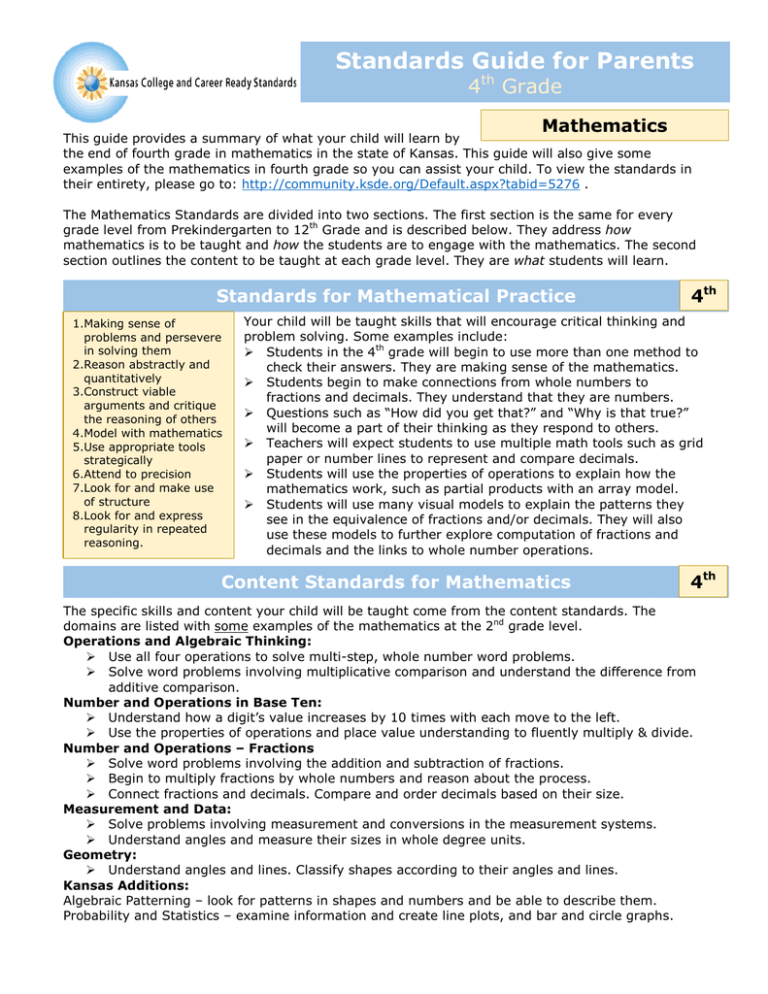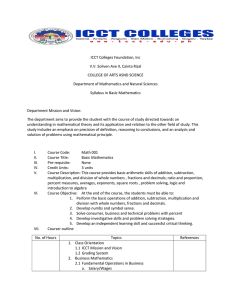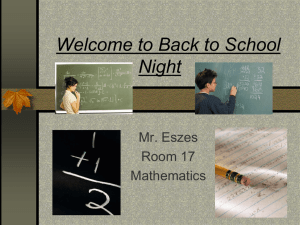Document 12021978
advertisement

Standards Guide for Parents 4th Grade Mathematics This guide provides a summary of what your child will learn by the end of fourth grade in mathematics in the state of Kansas. This guide will also give some examples of the mathematics in fourth grade so you can assist your child. To view the standards in their entirety, please go to: http://community.ksde.org/Default.aspx?tabid=5276 . The Mathematics Standards are divided into two sections. The first section is the same for every grade level from Prekindergarten to 12th Grade and is described below. They address how mathematics is to be taught and how the students are to engage with the mathematics. The second section outlines the content to be taught at each grade level. They are what students will learn. Standards for Mathematical Practice 1.Making sense of problems and persevere in solving them 2.Reason abstractly and quantitatively 3.Construct viable arguments and critique the reasoning of others 4.Model with mathematics 5.Use appropriate tools strategically 6.Attend to precision 7.Look for and make use of structure 8.Look for and express regularity in repeated reasoning. 4th Your child will be taught skills that will encourage critical thinking and problem solving. Some examples include: Students in the 4th grade will begin to use more than one method to check their answers. They are making sense of the mathematics. Students begin to make connections from whole numbers to fractions and decimals. They understand that they are numbers. Questions such as “How did you get that?” and “Why is that true?” will become a part of their thinking as they respond to others. Teachers will expect students to use multiple math tools such as grid paper or number lines to represent and compare decimals. Students will use the properties of operations to explain how the mathematics work, such as partial products with an array model. Students will use many visual models to explain the patterns they see in the equivalence of fractions and/or decimals. They will also use these models to further explore computation of fractions and decimals and the links to whole number operations. Content Standards for Mathematics 4th The specific skills and content your child will be taught come from the content standards. The domains are listed with some examples of the mathematics at the 2nd grade level. Operations and Algebraic Thinking: Use all four operations to solve multi-step, whole number word problems. Solve word problems involving multiplicative comparison and understand the difference from additive comparison. Number and Operations in Base Ten: Understand how a digit’s value increases by 10 times with each move to the left. Use the properties of operations and place value understanding to fluently multiply & divide. Number and Operations – Fractions Solve word problems involving the addition and subtraction of fractions. Begin to multiply fractions by whole numbers and reason about the process. Connect fractions and decimals. Compare and order decimals based on their size. Measurement and Data: Solve problems involving measurement and conversions in the measurement systems. Understand angles and measure their sizes in whole degree units. Geometry: Understand angles and lines. Classify shapes according to their angles and lines. Kansas Additions: Algebraic Patterning – look for patterns in shapes and numbers and be able to describe them. Probability and Statistics – examine information and create line plots, and bar and circle graphs. Activities for 4th Graders 4th grade students are expected to be able to round multi-digit numbers and to use estimation before computing. You can help you child more fully develop these skills by asking them doing some of the following activities: Ask your child to estimate the total bill at a restaurant. Give the separate items and ask for an approximate total. Then ask HOW that answer was reasoned through. Write out a number (can be from the hundreds to the millions) and then ask your child to round that number to the nearest hundred . . . thousand . . . hundred thousand . . . etc. th Factor Pairs 4 grade students are expected to be able to find all the factor pairs for various products. Get a deck of cards and pull out two cards – this is your two-digit number. Ask your child to give you all of the factor pairs for this number. Factor pairs are any two numbers that can be multiplied together to get a specific product. Example: If you gave your child the number 36 then these are the factor pairs 1 and 36 Note: If a number only has 1 and itself as a factor pair then it is a 2 and 18 special number called a prime number. If it has more than one 3 and 12 4 and 9 set of factor pairs then it is called a composite number. 6 and 6 Comparing Fractions Students continue working with fractions and build on concepts learned in 3rd grade. Comparing fractions becomes more important. Try these activities: In real life we frequently compare fractions by reasoning about their size and in relation to “benchmark fractions.” When cooking or measuring with fractional parts, take the opportunity to ask your child if 2/3 of a cup is closer to 1 cup or ½ cup? Then ask them to explain their thinking. Decimals are essentially fractions. When working with money ask your child if $0.65 is closer to half a dollar or a dollar and why. What would 0.65 look like in fraction form? Area and Perimeter 4th graders will be exploring area and perimeter. Often students confuse the two types of measure. You can assist your child’s understanding by frequently talking about both measures. This shape has an area of 8 square units and a perimeter of 12 units. Can I make another shape that has the same area but a different perimeter? What about the same perimeter but a different area? Talk about why.






